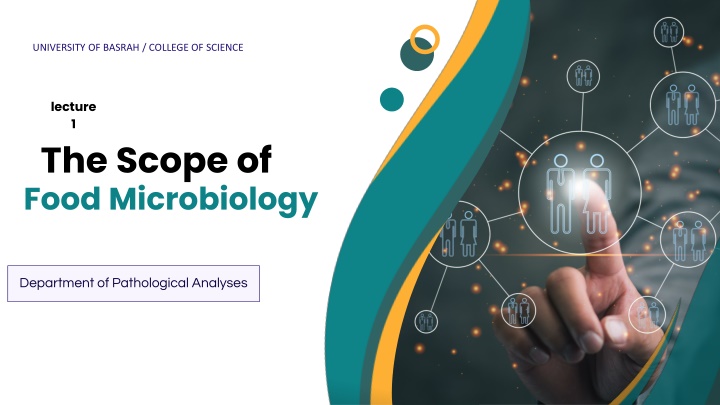
Importance of Food Microbiology in Modern Society
Explore the fascinating realm of food microbiology, shedding light on the crucial role microorganisms play in the food chain. Discover how these tiny organisms impact food spoilage, preservation techniques, and even foodborne illnesses.
Download Presentation

Please find below an Image/Link to download the presentation.
The content on the website is provided AS IS for your information and personal use only. It may not be sold, licensed, or shared on other websites without obtaining consent from the author. If you encounter any issues during the download, it is possible that the publisher has removed the file from their server.
You are allowed to download the files provided on this website for personal or commercial use, subject to the condition that they are used lawfully. All files are the property of their respective owners.
The content on the website is provided AS IS for your information and personal use only. It may not be sold, licensed, or shared on other websites without obtaining consent from the author.
E N D
Presentation Transcript
UNIVERSITY OF BASRAH / COLLEGE OF SCIENCE lecture 1 The Scope of Food Microbiology Department of Pathological Analyses
Microbiology is the science which includes the study of the occurrence and significance of bacteria, fungi, protozoa and algae which are the beginning and ending of complex food chains upon which all life depends. Most food chains begin, photosynthetic organisms can trap light energy and use it to synthesize large molecules from carbon dioxide, water and mineral salts forming the proteins, fats and carbohydrates which all other living creatures use for food. Within and on the bodies of all living creatures, as well as in soil and water, microorganisms build up and change molecules, extracting energy and growth substances. They also help to control population levels of higher animals and plants by parasitism and pathogenicity.
Microbiology When plants and animals die, their protective antimicrobial systems cease to function .Sooner or later, decay begins liberating the smaller molecules for re-use by plants. Without human intervention, growth, death, decay and regrowth would form a complex web of plants, animals and micro-organisms and varying with changes in climate . Often showing apparently chaotic fluctuations in populations of individual species, but inherently balanced in numbers between producing, consuming and recycling groups.
MICRO-ORGANISMS AND FOOD The foods that we eat are rarely if ever sterile, they carry microbial associations whose composition depends upon which organisms gain access and how they grow, survive and interact in the food over time. The micro-organisms present will originate from the natural micro- flora of the raw material and those organisms introduced in the course of harvesting/slaughter, processing, storage and distribution . In most cases this microflora has no discernible effect and the food is consumed without objection and with no adverse consequences. In some instances though, microorganisms manifest their presence in one of several ways:
Micro-organisms and food (i) they can cause spoilage. (ii) they can cause foodborne illness. (iii) they can transform a food s properties in a beneficial way food fermentation.
Food Spoilage/Preservation Historically, nuts and grains storage for winter provision was common among animals. However, with the advent of agriculture, safe storage of surplus production became crucial for effective use of seasonal growth patterns. Food preservation techniques were developed using microbiological principles to prevent decay. Seeds like rice, wheat, sorghum, millet, maize, oats, and barley were staple foods worldwide. Early methods relied on water activity reduction through solar drying, salting, concentrated sugar storage, or fire smoking. These methods could keep food for one or two seasons if properly dried.
Food Safety Food is valuable but also linked to disease transmission. Early sources like the Old Testament and Confucian, Hinduism, and Islam provide guidelines for food hygiene. Foodborne disease is perhaps the most widespread health problem in the contemporary world and an important cause of reduced economic productivity. (WHO 1992.). The available evidence clearly indicates that biological contaminants are the major cause.
